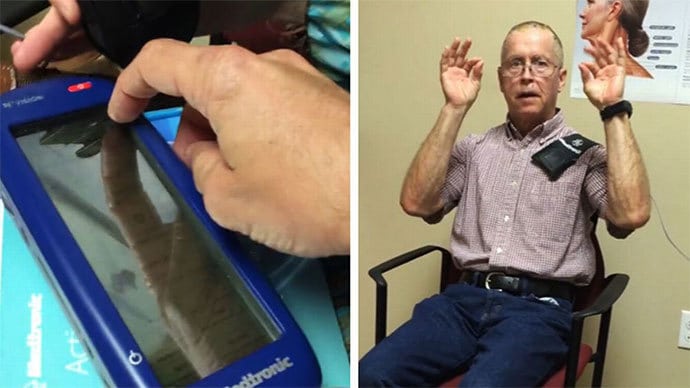There is no known cure for Parkinson’s yet, but the symptoms can be managed using drugs and therapies such as Deep Brain Stimulation. Deep Brain Stimulation uses an implanted neuro-stimulator to send electrical signals to targeted areas of the brain. The signals block the abnormal nerve signals and reverse and stop the tremors caused. The effect is immediate.
This treatment has been used successfully to control tremors in Parkinson’s patient as observed with Mr. Richardson. The Parkinson’s sufferer had the Deep Brain Stimulation system surgically implanted for treatment. In the video, he is experiencing a severe bout of tremors with visible shaking of hands and legs. Once the doctor presses the button on the device, Mr. Richardson’s tremors stop within seconds. It has been stated that he is no longer under Parkinson’s medication.
Parkinson’s Disease is a progressive neurodegenerative disorder that affects the body’s motor system. Patients suffering from this condition do not produce enough of the chemical dopamine which controls movement of the body. The most obvious symptoms of Parkinson’s are shaking, difficulty in walking, rigidity, and slowness in walking. Over time other symptoms such as dementia, depression and pain become manifest.
How It Works
During Deep Brain Stimulation, the neuro-stimulator is surgically implanted into a specific target within the brain – where the Parkinson’s Disease symptoms are generated. The device sends electrical impulses to the identified target in the brain that will be stimulated. The areas in the brain to be stimulated could be the globus pallidus internus, the subthalamic nucleus, or the thalamus.
The Deep Brain Stimulation system consists of three components: the lead, an extension, and the implanted pulse generator (IPG). The lead is a small insulated wire that is implanted into the brain through a small opening in the skull. The extension is an insulated wire that runs under the skin from the head through the neck onto the shoulder. It connects the lead to the IPG. The implanted pulse generator otherwise known as the neurostimulator is implanted under skin near the collarbone or in the abdomen.
After the Deep Brain Stimulation procedure, many patients experience tremendous improvement in their Parkinson’s symptoms. Some go off all medications completely, while some may still require taking the medication albeit in reduced dosages. The reduced dosages are associated with reduced side effects of the drugs such as infections or stroke.
Deep Brain Stimulation is primarily used for patients whose medication no longer controls their symptoms. It is also used in patients who experience severe side effects from the drugs.
Side Effects of the Treatment
Despite the success of Deep Brain Stimulation on many patients, it has the potential for numerous side effects such a hallucinations, depression, cognitive dysfunction, and apathy. These side effects are associated with the placement of the electrode and can be corrected by proper placement. The risk of infection, bleeding or the body rejecting the electrode is also apparent before, during and after the procedure.
The benefits of Deep Brain Stimulation far surpass its negative effects and the procedure is highly recommended for those whose Parkinson’s Disease symptoms interfere with their daily activities.
H/T: Mirror




 English
English